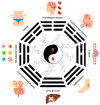A Literature Review of the Pharmacological Effects of Jujube
- PMID: 38254493
- PMCID: PMC10814260
- DOI: 10.3390/foods13020193
A Literature Review of the Pharmacological Effects of Jujube
Abstract
Jujube is a plant native to China that could be used in medicine and food. Its dried fruit is a superior herb commonly used in traditional Chinese medicine formulations for its calming effect and for nourishing the blood and strengthening the spleen and stomach. Jujube contains numerous active components including polysaccharides, phenols, and triterpene acids, which show a diverse array of pharmacological activities such as neuroprotection and the prevention and treatment of cardiovascular diseases. In this paper, the research status of jujube over the past two decades has been statistically evaluated. Meanwhile, by tracking the latest research advances, the pharmacological efficacy and molecular mechanisms of jujube are exhaustively expounded to provide specific and systematic references for further research on the pharmacological effects of jujube and its application in the food and pharmaceutical industries.
Keywords: active ingredient; jujube; pharmacological effect.
Conflict of interest statement
The authors declare no conflict of interest.
Figures
Similar articles
-
A Review of Edible Jujube, the Ziziphus jujuba Fruit: A Heath Food Supplement for Anemia Prevalence.Front Pharmacol. 2020 Nov 26;11:593655. doi: 10.3389/fphar.2020.593655. eCollection 2020. Front Pharmacol. 2020. PMID: 33324222 Free PMC article. Review.
-
Isolation, structures and bioactivities of the polysaccharides from jujube fruit (Ziziphus jujuba Mill.): A review.Food Chem. 2017 Jul 15;227:349-357. doi: 10.1016/j.foodchem.2017.01.074. Epub 2017 Jan 17. Food Chem. 2017. PMID: 28274443 Review.
-
Research advances in bioactive components and health benefits of jujube (Ziziphus jujuba Mill.) fruit.J Zhejiang Univ Sci B. 2021 Jun 15;22(6):431-449. doi: 10.1631/jzus.B2000594. J Zhejiang Univ Sci B. 2021. PMID: 34128368 Free PMC article. Review.
-
Triterpenoids in Jujube: A Review of Composition, Content Diversity, Pharmacological Effects, Synthetic Pathway, and Variation during Domestication.Plants (Basel). 2023 Mar 29;12(7):1501. doi: 10.3390/plants12071501. Plants (Basel). 2023. PMID: 37050126 Free PMC article. Review.
-
Bioactive triterpenes of jujube in the prevention of colorectal cancer and their molecular mechanism research.Phytomedicine. 2023 Feb;110:154639. doi: 10.1016/j.phymed.2022.154639. Epub 2023 Jan 2. Phytomedicine. 2023. PMID: 36608502
Cited by
-
Ziziphus jujuba: Applications in the Pharmacy and Food Industry.Plants (Basel). 2024 Sep 29;13(19):2724. doi: 10.3390/plants13192724. Plants (Basel). 2024. PMID: 39409594 Free PMC article. Review.
-
Insights into bioactivity guided chemical profiling of Ziziphus jujuba Mill. fruits wild-growing in Montenegro.Heliyon. 2024 Dec 19;11(1):e41361. doi: 10.1016/j.heliyon.2024.e41361. eCollection 2025 Jan 15. Heliyon. 2024. PMID: 39811273 Free PMC article.
-
Ziziphus jujube promotes fertility and pregnancy outcomes in Rat model of uterine adhesions.Front Pharmacol. 2025 Jan 27;15:1496136. doi: 10.3389/fphar.2024.1496136. eCollection 2024. Front Pharmacol. 2025. PMID: 39931514 Free PMC article.
-
Enhancing the Physicochemical Properties, Bioactivity, and Functional Applications of Fresh Jujube Juice Using Media Milling.ACS Omega. 2025 Mar 18;10(12):12603-12614. doi: 10.1021/acsomega.5c00475. eCollection 2025 Apr 1. ACS Omega. 2025. PMID: 40191370 Free PMC article.
-
Smartphone-Based SPAD Value Estimation for Jujube Leaves Using Machine Learning: A Study on RGB Feature Extraction and Hybrid Modeling.Sensors (Basel). 2025 Apr 17;25(8):2545. doi: 10.3390/s25082545. Sensors (Basel). 2025. PMID: 40285234 Free PMC article.
References
-
- Li H., Liang L., Li X. Treatise on Typhoid and Miscellaneous Diseases. Beijing Science and Technology Press; Beijing, China: 2014.
-
- Yang S.S., Xiao Y.P., Wang H.T., Li Y. Yellow Emperor’s Classic of Internal Medicine. People’s Medical Publishing House; Beijing, China: 1955.
-
- Gu G.G. Shennong’s Herbal. Lanzhou University Press; Lanzhou, China: 2004.
Publication types
Grants and funding
LinkOut - more resources
Full Text Sources
Miscellaneous



